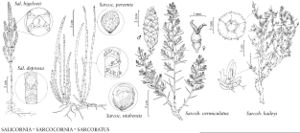Sarcobatus
in M. P. zu Wied, Reise Nord-Amer. 1: 510. 1839.
Shrubs, deciduous, monoecious, glabrous or pubescent. Stems erect, much-branched, not jointed, dimorphic, not fleshy; long-shoots solitary, axillary, elongate, bearing leaves and axillary thorns; short-shoots clustered, budlike, usually subtending thorns or lateral branches, bearing leaves; thorns 1 (–2) per node. Leaves mostly alternate on long-shoots (sometimes opposite proximally) or clustered (“tufted”) on short-shoots, sessile, succulent; blade linear, nearly terete to somewhat flattened, margins entire, apex obtuse (mucronate). Inflorescences: pistillate flowers solitary or paired in axils of foliage leaves; staminate inflorescences distal to pistillate, terminal, pedunculate, cylindric spike of 10–40 spirally arranged flowers. Flowers unisexual, ebracteolate; pistillate sessile (sometimes short-pedunculate in fruit); “perianth” accrescent, adnate, cuplike, margins subentire to shallowly lobed, flaring to form wing in fruit; stigmas 2; staminate flowers: perianth absent; anthers caducous, (1–) 2–4 (–5), almost sessile, arising from spike axis and around stalk of persistent, overtopping and concealing, eccentrically peltate, rhombic, scarious scale. Fruiting structures: fruits achenes, proximal portion below wing turbinate, enlarging less than distal portion; distal portion above wing conic; wing sometimes red-tinged, veiny, broad, margins shallowly to deeply lobed, undulate, crenulate to erose. Seeds vertical, flattened, orbiculate; seed-coat transparent, membranous; perisperm absent. x = 9.
Distribution
North America, including nw Mexico
Discussion
Species 2 (2 in the flora).
Sarcobatus was considered monotypic until F. V. Coville published a second species, from western Nevada. The following features have been used (with variable success) to separate the taxa: stature, bark color, leaf length and vestiture, fruit dimensions and vestiture, length of staminate spikes, and number of pistillate flowers per flowering branch. Sarcobatus baileyi has been treated as a species by some, as S. vermiculatus var. baileyi (Coville) Jepson by others, as an unnamed form, and as a taxon not worthy of recognition. Further study may resolve its status; we prefer to maintain the specific rank originally assigned to it.
Plants of Sarcobatus are divaricating shrubs, with elongate lateral branches and thorns extending from the main stems at more-or-less right angles, resulting in a tangle of branches and thorns in mature individuals. In addition to elongate lateral branches, they also have short budlike shoots, often clustered into a “cushionlike” structure, that subtend these elongate lateral branches or thorns (i.e., in the position of leaf scars). One key difference between the species is the abundance and behavior of these short shoots and how they produce additional lateral leafy and flowering branches.
The two species of Sarcobatus can grow together and may intergrade. Many equivocal specimens can be identified as either somewhat depauperate S. vermiculatus or somewhat robust S. baileyi, both apparently resulting from intermediate soil-moisture conditions or possibly as a response to infestation by fungi or arthropods. Other specimens are problematical, combining in various degrees the features allegedly defining the two taxa. Assigning such specimens to either of the taxa requires a certain amount of arbitrariness; some specimens we cannot determine with certainty. Collectors should record notes on habit, height, and foliage color; photographs of the plants may be helpful. Occasional individuals may be F1 hybrids, being intermediate in morphology, having malformed leaves and inflorescences, and appearing to be sterile.
We have seen a few equivocal specimens of Sarcobatus that look disfigured and show numerous, large, dense, short shoots with numerous leaves, giving the appearance of witches’-broom disease. These short shoots, although resembling those of S. baileyi, are unlike those of either species because they are much larger and possess many more leaves than occur on typical short shoots. In addition, the long shoots on these anomalous specimens are like those characteristic of S. vermiculatus.
Selected References
Lower Taxa
Key
| 1 | Leaf blades usually glabrous, or slightly pubescent, bright green to yellowish green in life, (0.3-)1.5-4(-5) cm; leaves mostly solitary on elongate shoots of current season; pistillate flowers and staminate spikes on long lateral branches with 3-9 readily visible internodes; staminate spikes at maturity usually 11-40 mm; widespread in w North America | Sarcobatus vermiculatus |
| 1 | Leaf blades usually pubescent, dull green to grayish green in life, (0.5-)1-1.6 cm; leaves mostly clustered on cushionlike base on older wood; pistillate flowers and staminate spikes on short branches with 1-3 barely discernible internodes; staminate spikes at maturity usu- ally to 10 mm; Nevada | Sarcobatus baileyi |
